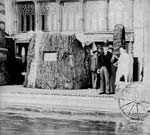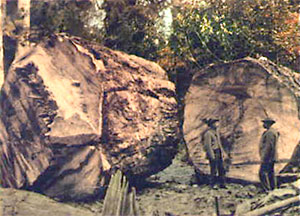 In
a day or two Elmer E. Johnston, commissioner from the State of Washington, will
move into the most unique office occupied by any commissioner at the Pan-American.
(thumbnail at right links to larger view.)
In
a day or two Elmer E. Johnston, commissioner from the State of Washington, will
move into the most unique office occupied by any commissioner at the Pan-American.
(thumbnail at right links to larger view.)Commissioner to Have His Office in a Big Hollow Tree
Buffalo Courier, August 7, 1901
 In
a day or two Elmer E. Johnston, commissioner from the State of Washington, will
move into the most unique office occupied by any commissioner at the Pan-American.
(thumbnail at right links to larger view.)
In
a day or two Elmer E. Johnston, commissioner from the State of Washington, will
move into the most unique office occupied by any commissioner at the Pan-American.
(thumbnail at right links to larger view.)
This is nothing less than the hollowed section of one of the gigantic fir trees of Washington, the largest, in fact, which has ever been moved out of the State. Mr. Johnston's office stands ten feet high and has a diameter of thirteen feet six inches. Sixty-five people have crowded inside at one time, though, when he gets his office furniture installed there will not be room for so many.
The office is located on the north porch of the Agriculture Building, which is nearly filled with that and kindred exhibits, all showing the timber resources of the State of Washington. To show that the big tree was not "made" but really grew, a cross section a foot thick has been brought along. This was intended to furnish a roof to the office, but it was found impossible to elevate it to its position, so it has been stood up on edge close by, where it affords visitors a much better idea of its size than they could get if it were in its intended position.
 The
accompanying pictures show the big log as it appeared when felled in the forest.
One of the pictures shows two sections. it is the smaller section, the one in
the background, which has been brought here. The other and larger was not brought
because a tree always breaks at the stump when falling, rendering it impossibe
to get the first section clear. The picture showing the large group of men shows
the size of the logging crew which was required to fell the tree.
The
accompanying pictures show the big log as it appeared when felled in the forest.
One of the pictures shows two sections. it is the smaller section, the one in
the background, which has been brought here. The other and larger was not brought
because a tree always breaks at the stump when falling, rendering it impossibe
to get the first section clear. The picture showing the large group of men shows
the size of the logging crew which was required to fell the tree.
This giant of the forest stood about 250 feet high, 150 feet to the first limb. At its lowest cut the stump was 15 feet six inches in diameter and forty-nine feet six inches in circumference. It is estimated to contain 75,000 feet of merchantable lumber.
"This is not the largest tree that we have in Washington," said Commissioner Johnston, "neither is it the largest which has ever been felled there, but it is the largest one we could conveniently bring. It had to be hollowed out because it couldn't be brought on any freight car, but the cross section whcih we show with it is evidence of the fact that it really grew. It is larger than the great tree which created such a furor at the World's Fair, and is, in fact, the largest tree which was ever taken out for exhibition purposes, though larger have been handled and taken to the mills in practical logging operations."
Shown with the big tree as part of Washinton's forestry exhibit is a curiosity in the shape of the stump of a spruce tree, which has grown over the trunk of a fallen cedar. The cut includes a part of the cedar and is taken in such a way as to show the way the spruce grew while in the forest. By the side of this forestry curiosity lies a bunch of shingles manufactured from a cut from the same fallen cedar. The shingles are just as sound as if cut from a freshly felled tree.
"It is not an unusal thing at all to find such growths in Washington forests," said Commissioner Johnston. "The purpose of bringing this one here is not so much for its curiosity as to demonstrate what we are pleased to call the practically indestrucible qualities of Washington cedar. Put it in shingles on your roof and it will last forever, and we have enough of it out in Washington to roof every building in America.
"We have brought our large tree here to attract your attention long enough for us to tell you that we have other large things out in Washington, some of them that we couldn't conveniently bring, for we are 3,000 miles away from home, and a new state without the organization for making such exhibits as this.
"For instance, we have cabbages which will just go in a barrel. We grow apples as big as a child's head, we have the longest straw on exhibit in the Agricultural Building, and when any practical farmer looks at that straw he knows that it will grow the biggest crops to the acre raised anywhere. We didn't get our appropriation till late last spring and our agricultural and horticultural exhibits are what we could pick up from last year's crop. We are not ashamed of our exhibits as they stand. They compare favorably with any at the Exposition, but in about two weeks we will begin to get in samples of this year's crops, and then we will show you something."